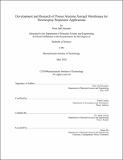| dc.contributor.author | Hannahs, Maia Hall. | en_US |
| dc.contributor.other | Massachusetts Institute of Technology. Department of Materials Science and Engineering. | en_US |
| dc.date.accessioned | 2021-10-08T16:47:56Z | |
| dc.date.available | 2021-10-08T16:47:56Z | |
| dc.date.copyright | 2020 | en_US |
| dc.date.issued | 2020 | en_US |
| dc.identifier.uri | https://hdl.handle.net/1721.1/132796 | |
| dc.description | Thesis: S.B., Massachusetts Institute of Technology, Department of Materials Science and Engineering, May, 2020 | en_US |
| dc.description | Cataloged from the official PDF version of thesis. "May 2020." | en_US |
| dc.description | Includes bibliographical references (pages 36-38). | en_US |
| dc.description.abstract | Electrospray engines have been under development at the MIT Space Propulsion Laboratory (SPL) for many years. The operating principle of electrospray engines is a voltage drives a charged liquid fuel through an extractor membrane, the momentum of the exiting fuel is what propels the engine. The extraction membrane must have a specific geometry of an array of tips to allow for the amount and direction of the fuel emitted to be controlled. The membrane also must not react with the fuel under high voltages, and must be stable in the extreme conditions of space. Therefore this thesis discusses the past materials which have been used as candidates for this application and a discussion of electrospray performance in comparison to other forms of electric propulsion. The experimental section specifically focusses on cast alumina xerogels (porosities less than 90% typically around 40-50%) and briefly investigates a manufacturing procedure. The main problem facing the performance of these extractor membranes is the consistency of their geometry and porosity given the manufacturing constraints to make these engines easily scalable and relatively cheap. Xerogels are prepared through the sol-gel method can be cast into the emitter tip array, are synthesized from a liquid solution, and their porosity and total density can be affected through the drying conditions or sintering. To simplify the manufacturing process these samples were allowed to dry slowly by partial exposure to air. Many of the samples cracked but also exhibited very uniform pore size and distribution. So a discussion of possible ways to best control the solvent removal without straining the structure follows, as well as a discussion of possible characterization methods. | en_US |
| dc.description.statementofresponsibility | by Maia Hall Hannahs. | en_US |
| dc.format.extent | 38 pages | en_US |
| dc.language.iso | eng | en_US |
| dc.publisher | Massachusetts Institute of Technology | en_US |
| dc.rights | MIT theses may be protected by copyright. Please reuse MIT thesis content according to the MIT Libraries Permissions Policy, which is available through the URL provided. | en_US |
| dc.rights.uri | http://dspace.mit.edu/handle/1721.1/7582 | en_US |
| dc.subject | Materials Science and Engineering. | en_US |
| dc.title | Development and research of porous alumina xerogel membranes for electrospray propulsion applications | en_US |
| dc.type | Thesis | en_US |
| dc.description.degree | S.B. | en_US |
| dc.contributor.department | Massachusetts Institute of Technology. Department of Materials Science and Engineering | en_US |
| dc.identifier.oclc | 1262873583 | en_US |
| dc.description.collection | S.B. Massachusetts Institute of Technology, Department of Materials Science and Engineering | en_US |
| dspace.imported | 2021-10-08T16:47:55Z | en_US |
| mit.thesis.degree | Bachelor | en_US |
| mit.thesis.department | MatSci | en_US |
